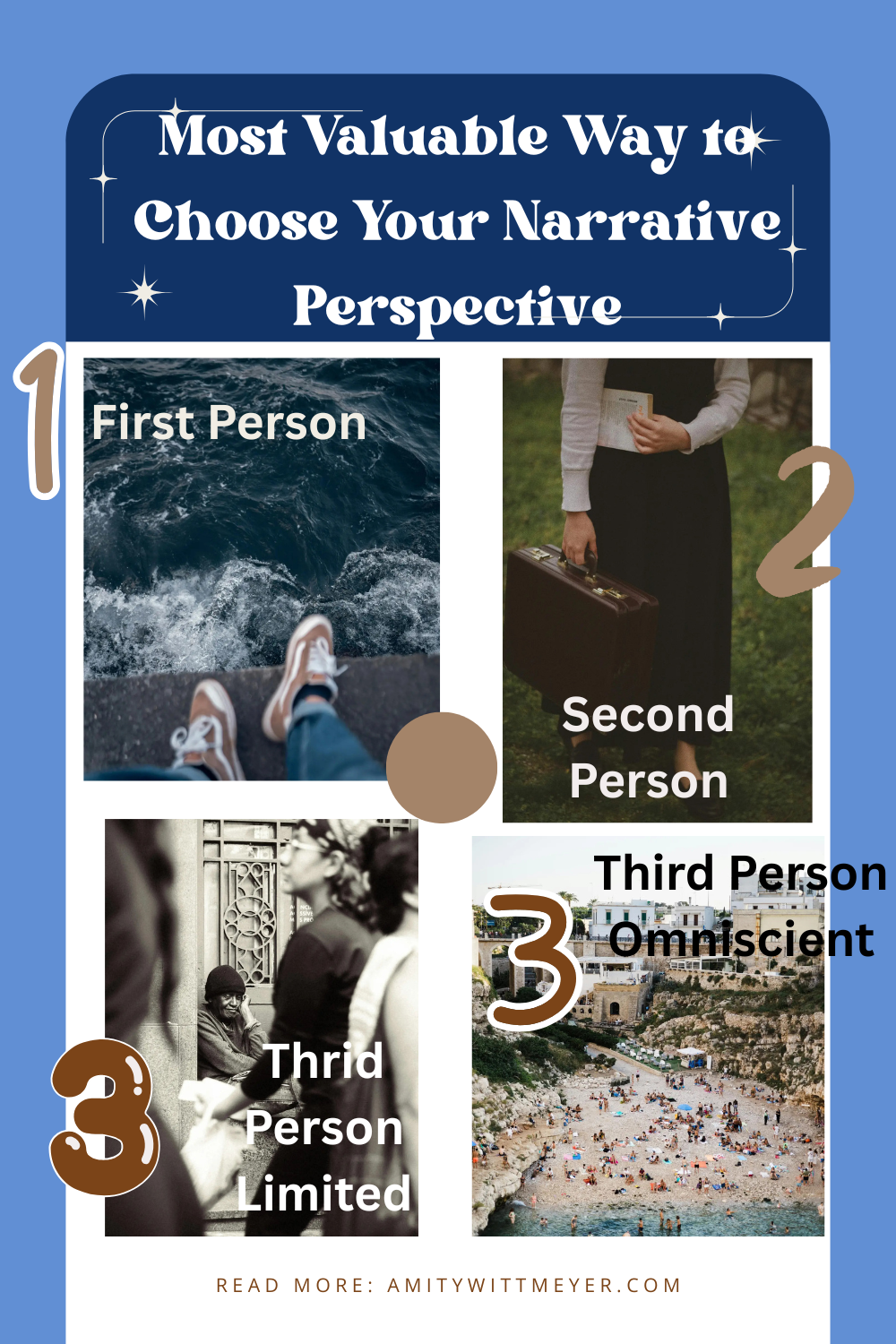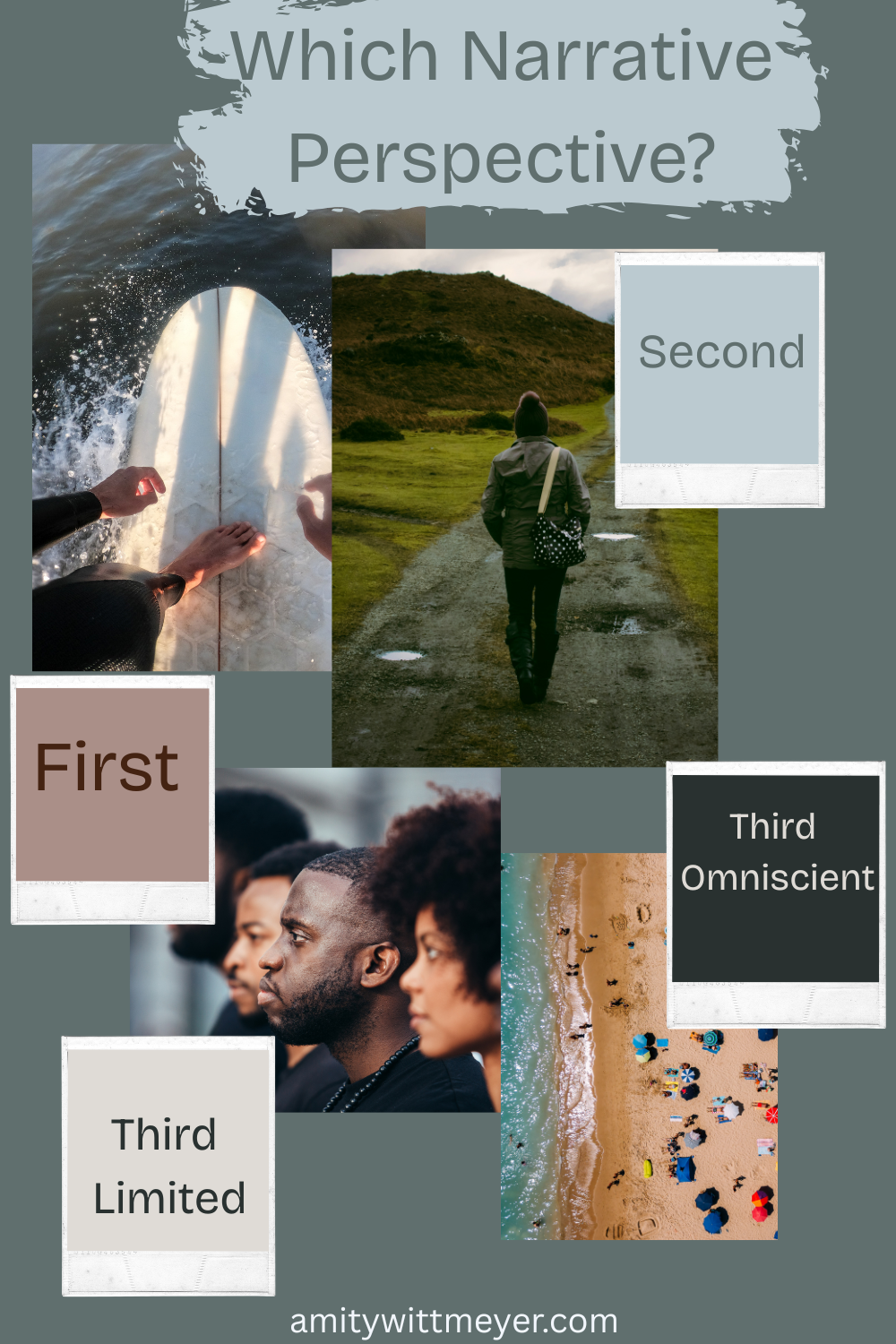Disclaimer: This post may contain affiliate links, which means we may receive a commission at no cost to you if you make a purchase through a link below.
Creating a new story can be tough. The first step is picking your narrative perspective, deciding who is telling it, and why. By the end of this blog post, you’ll have a better understanding of which perspective your next story should be told in.
What are the Different Narrative Perspectives?
The perspective is a story’s point of view. Each story could be completely retold in a new way just by changing who is telling it. The various perspectives include first-person, second-person, third-person limited, and third-person omniscient. Let’s break these down.
First-Person Perspective
To begin, writing a story in the first-person perspective means the story is being told through one narrator. Think I/We statements. This way will only show one angle of a story. Generally, it includes how this character is feeling, thinking, and processing various events.
According to Grammarly,
“First-person point of view provides a personal and subjective experience, allowing readers to see and feel the story directly from the author’s perspective.”
So, when do you use this? While it can be great to use third-person because you can hear what’s happening to other characters, first-person narration shapes how the reader should feel.
Ultimately, when a story follows one character closely, it is natural for the reader to want to trust them since it’s the only side of the story you get.
First-person narration can be a really fun way to explore the opposite of the common hero. This is called an unreliable narrator.
By definition, they lie and display irregular behavior to make the reader question their likability and distrust them. In conclusion, villain stories in the first person can be a great example of this.
Recommendations:
Ultimately, some great examples of first-person narrative novels for your next read are American Psycho, “Benito Cereno,” Lolita, Catcher in the Rye, and The Great Gatsby. I highly recommend grabbing these books to better understand this perspective and enjoy award-winning writing!
American Psycho
To begin, let’s start with American Psycho. We only get information Patrick deems worthy of sharing about his violent lifestyle. Additionally, we only get his perspective on his crimes, as he denies accountability. Instead, he actually supports his horrendous actions as reasonable or even necessary.
“Benito Cenero”
To add to the list, I will talk about the short story “Benito Cereno” by Herman Melville. In the tale, an American captain named Delano, whose privilege and trusting spirit narrates his interaction with the supposed captain of a slave ship that recently mutinied.
Through his perspective, he reveals that the slaves are now in charge. Additionally, he realizes they are holding the captain hostage after ignorantly misinterpreting various pieces of evidence.
Since we get Captain Delano’s perspective, the subtle irregularities within the ship that are brought to his attention make the story more of a tense mystery. The perspective allows for the uncovering of multiple aspects of racism at the time.
To quote Sparknotes,
“Melville makes it abundantly clear throughout the novella that Delano is unable to comprehend what is really going on aboard the San Dominick because he is too caught up in the way things should be to process what is actually happening.”
Melville exploited the typical white man of the time, holding their racial prejudices and assuming power in any circumstance, to allow the reader to also misinterpret the truth, at least for a while.
Because of this, I could not stress how much I recommend this book to fully comprehend how the narrative perspective you choose can make or break your story, as its power changes the reader’s interpretation and overall message revealed.
More Examples:
First-person shapes how your reader views your story and your characters.
- For instance, think of Lolita, a story told by a pedophile who excuses his crimes and even attempts to get the reader to pity him.
- In addition, what about Holden from The Catcher in the Rye, who is widely agreed to be the perfect example of an unreliable narrator, misinterpreting events, lying, through a judgmental perspective?
First-person can also be a great way to add mystery to other characters, while your narrator is more of a side character to the action, set apart from it, and yet paints a good picture of the tale to the reader.
- For instance, Nick’s narration in The Great Gatsby makes Jay Gatsby look like a magician. He pulls off great feats, unexplained to the reader for most of the novel, only to elevate his intrigue and mystery.
Second-Person Perspective
First-person is in the perspective of one character, whereas second-person allows the reader to “get in on the action.” This narration uses YOU. YOU are at a crossroads. YOU start to feel terrible. YOU decide to move forward with the plans.
Second-Person jumps the reader into your story. Therefore, you can do whatever you want with them. For example, scare them! Excite them! Make them see a new perspective on life.
Nonfiction self-help books are a great example of using the second-person. Poetry is another great example.
The Problem with Second Person Narrative Perspective:
Unfortunately, it can be difficult to stay in this narration since writers may tend to start to throw in their perspective. Therefore, be vigilant in remembering that the reader is your main character. The tricky part is also immersing your reader. Make them believe they are there.
To quote Masterclass and their article, “What Is Second Person Point of View in Writing? How to Write in Second Person Narrative Voice With Examples,”
“People are used to making observations when reading a book. If you put the responsibility of character or protagonist on the reader, it’s your job to make it credible. Bring them into the world by elaborating on details. Appeal to their senses and emotions with vivid detail to describe the setting, other characters, and events.”
Push the details and take them into your world. Truly get them imagining what’s happening to them. It helps to stay in the present, using active, not passive voice.
Example:
Remember the hit Netflix show You? Similar to other popular shows and movies, it was based on a book. A book written in second-person naturally. Caroline Kepnes tells a story of a stalker obsessing over staying in a woman’s life.
The book remains in second-person as the stalker continues to think and watch a woman. However, the second-person narrative makes the reader feel they are the victim too. This adds a thrilling suspense to a, at first, seemingly harmless romance.
Third-Person Limited Perspective
Moving along, a third-person limited narration is finally where we get less information. The narration follows a single character, telling the reader their thoughts and feelings. However, the reader isn’t getting this information from them.
There are no “I feel” statements. Think of it as a camera following an individual. You see what they do, but you don’t necessarily understand their actions or hear their thoughts.
Unlike with a first-person perspective, we don’t have a character’s view distracting us from the actual truth. The reader can’t be fooled by an unreliable narrator.
To quote the writer’s digest in their article “Third-Person Limited: Analyzing Fiction’s Most Flexible Point of View,”
“The ability to convey a character’s thoughts—and then back away when you’d like to mute their thoughts—is a critical difference from first person. The narrator can sit on the protagonist’s shoulder for some parts of the story, then back away for other parts.”
In summary, this perspective is a great way not to reveal too much. At the same time, it gives your reader some wiggle room to figure out your protagonist’s needs and wants on their own.
Recommendation:
I recommend reading The Giver. just to help see this perspective in text, but also, because the symbolism overall is very powerful.
To add to that, the reader doesn’t get what Jonas is feeling or thinking. However, they slowly uncover truths about his dystopian society as he does. Therefore, the beauty that comes with freedom is actualized as the story continues.
Third-Person Omniscent Perspective
Wrapping up, this perspective can be better remembered if you think the story was written by a god in the sky. You see everyone and know how everyone is feeling.
While playing “god” you allow the reader to know multiple perspectives of the story, thoughts, and feelings of many, sometimes in the same scene. It’s a quick way to share a lot of information in a short amount of time.
Additionally, the writer is able to share with the reader information or foreshadowing of the story before the characters themselves are aware of the truth.
To quote Scribophile in their article “Third Person Omniscient Point of View: The All-Knowing Narrator,”
“This allows the writer to show an interpretation of events that occur within the story for each unique character.”
You can fit in more characters this way. Using this perspective can be best for books set in a huge world with many characters.
Recommendations:
While many novels come to mind, I will recommend my favorites that have stood the test of time for their themes, character development, and imagery. Give Middlemarch, Beloved, and Their Eyes Were Watching God a chance for your next book to study the third-person narrative omniscient perspective.
Diving in, let’s discuss my examples.
- Middlemarch by George Eliot involves various families and subplots. It provides a deeper understanding of the layout of the world it’s set in and the social norms of the time.
- Beloved by Toni Morrison switches from first-person accounts. However, it mostly stays in third-person omniscient. The reader then sees the moral dilemma behind Sethe’s actions in killing her daughter. They also see how it has affected her and the other characters.
- Lastly, Their Eyes Were Watching God is another great example. It shows societial expectations around being a woman, falling in love, and other themes of identity.
Closing
The next time you are starting a story, think about who is telling it and why. You can hide or reveal many details from your choice. How you choose to reveal your plot will depend on who is figuring it out in the first place.
Is it one character, multiple, or is it your reader?





